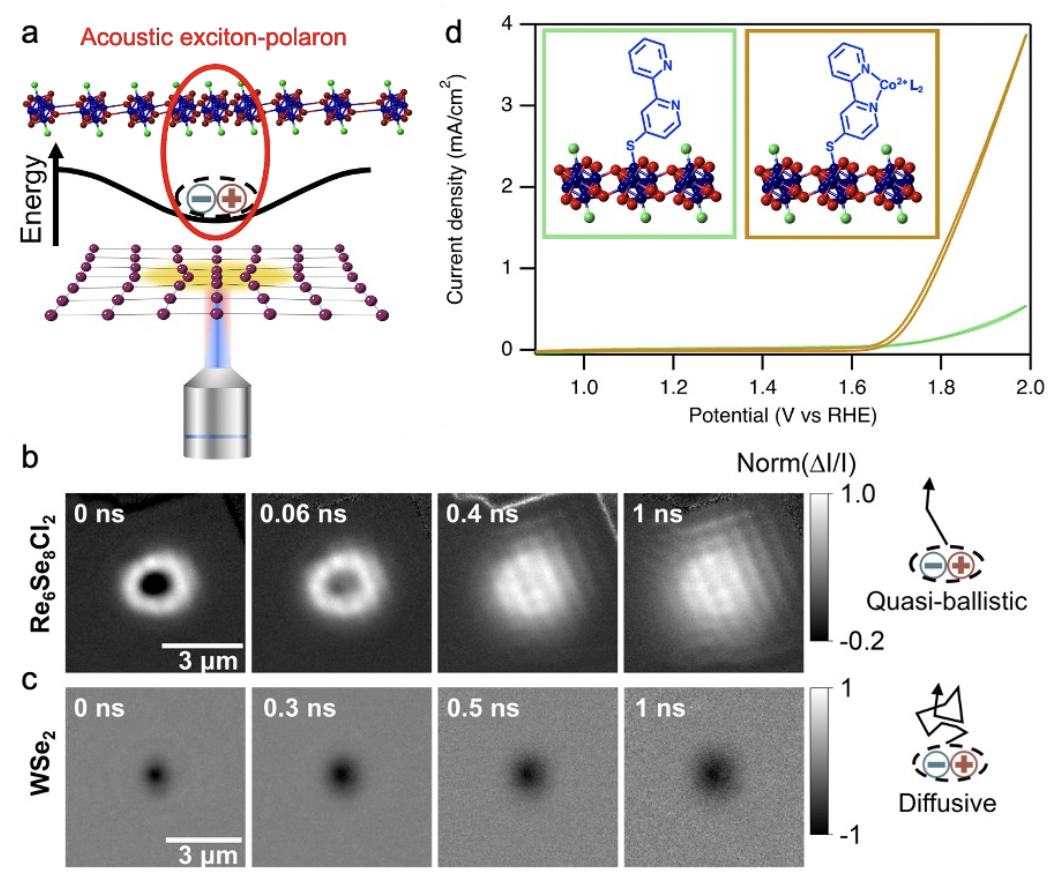 The transport of energy and information in semiconductors is limited by scattering between electronic carriers and lattice phonons, resulting in diffusive and lossy transport that curtails all semiconductor technologies. Using Re6Se8Cl2, a van der Waals (vdW) superatomic semiconductor, IRG2 PIs have demonstrated the formation of acoustic exciton-polarons, an electronic quasiparticle shielded from phonon scattering (Fig. 1a). Polaron transport in Re6Se8Cl2 is directly image at room temperature (Fig. 1a), revealing quasi-ballistic, wavelike propagation sustained for nanoseconds and several microns. Shielded polaron transport leads to electronic energy propagation orders of magnitude greater than in other vdW semiconductors (Fig. 1b,c), exceeding even silicon over nanoseconds. We propose that, counterintuitively, quasi-flat electronic bands and strong exciton–acoustic phonon coupling are together responsible for the remarkable transport properties of Re6Se8Cl2, establishing a new path to ballistic room-temperature semiconductors. This work, recently accepted for publication in Science, is a major step in the long and active search for room-temperature ballistic semiconductors, which could power next-generation technologies such as lossless transistors operating over three orders of magnitude faster than current electronics.
The transport of energy and information in semiconductors is limited by scattering between electronic carriers and lattice phonons, resulting in diffusive and lossy transport that curtails all semiconductor technologies. Using Re6Se8Cl2, a van der Waals (vdW) superatomic semiconductor, IRG2 PIs have demonstrated the formation of acoustic exciton-polarons, an electronic quasiparticle shielded from phonon scattering (Fig. 1a). Polaron transport in Re6Se8Cl2 is directly image at room temperature (Fig. 1a), revealing quasi-ballistic, wavelike propagation sustained for nanoseconds and several microns. Shielded polaron transport leads to electronic energy propagation orders of magnitude greater than in other vdW semiconductors (Fig. 1b,c), exceeding even silicon over nanoseconds. We propose that, counterintuitively, quasi-flat electronic bands and strong exciton–acoustic phonon coupling are together responsible for the remarkable transport properties of Re6Se8Cl2, establishing a new path to ballistic room-temperature semiconductors. This work, recently accepted for publication in Science, is a major step in the long and active search for room-temperature ballistic semiconductors, which could power next-generation technologies such as lossless transistors operating over three orders of magnitude faster than current electronics.
Using Re6Se8Cl2 as a superatomic pegboard, the IRG2 team have also developed robust and general method to functionalize 2D superatomic sheets with high precision and controllable densities. Fig. 1d shows the covalent attachment of 2,2’-bipyridine (bipy) ligands to exfoliated Re6Se8Cl2 sheets through radical-based Cl substitution. These ligands can bind molecular Co catalysts, and with no optimization, the resulting surface-tethered complexes catalyze the oxidation of water with no release or decomposition of the Co complex.